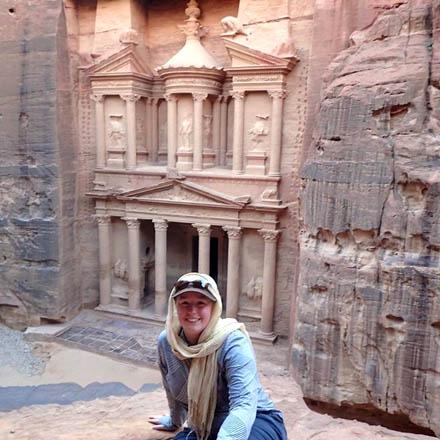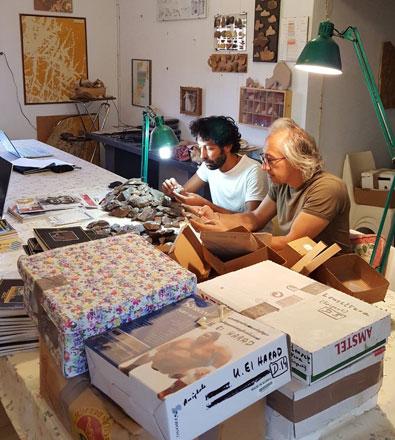You are here
American geographer explores ancient rock art in Wadi Rum
By Saeb Rawashdeh - Aug 31,2017 - Last updated at Aug 31,2017

Kaelin Groom (Photo courtesy of Kaelin Groom)
AMMAN — Although her first trip to the Kingdom was short, Kaelin Groom, a geographer specialised in geomorphology and heritage science, instantly fell in love with the landscape and the people of Jordan, knowing that, one day, she would come back.
“When the opportunity arose to conduct this project, I was all over it,” she noted after conducting a lecture on “Community Engagement in Rock Art Management in Wadi Rum” held at the American Centre of Oriental Research recently.
Groom, who has extensive research experience working with rock art in the US Southwest, applied similar methods in juncture in Wadi Rum, 328km south of Amman.
The documentation team members “were engaged and excited to be contributing to the research and hopeful for protection of the Wadi’s varied inscriptions. With their hardwork, as well as the work conducted by the Core Team in April and June, we have been able to analyse nearly 550 individual rock art and inscription panels throughout the protected area”, the scholar, who received a PhD in Environmental Dynamics form the University of Arkansas said.
“Each of these findings is associated with a point in the project’s online GIS database, along with corresponding photographs. There is still a lot of work to be done, but the general mood following this mission is good, which is necessary to keep things moving in the future,” the scholar told The Jordan Times in an e-mail interview.
Her current research includes analysing cavernous rock decay (tafoni), quantifying tangible impacts of tourism in culturally protected landscapes and serving as an advocate for rapid field assessments for cultural stone decay and heritage management.
However, she faces various obstacles in her research: “There were several challenges associated with this project,” she said.
“The first dealt with the research methods themselves. This was the first time the Rock Art Stability Index [RASI] had been translated into another language, so it was new territory for both the local team and the RASI experts.”
After a preliminary translation by one of the Jordanian scholars, Zeyadal Salameen, and several days spent in the field with the team to gain greater familiarity with the index, researchers and local team members were able to work together to find better terminology for a more accurate translation, Groom said.
She added that geo-technical issues also arose with the new tablets used for the project, sign in credentials for the online GIS, as well as mechanical hiccups with the GigaPan robotic camera mount.
Meanwhile, some of the more cultural or “sensitive” challenges of the mission were less “blatant” but still there, she said.
Despite most members being “highly dedicated” to the work, a few of the documentation team members “were not always present”, or “only minimally” contributed, she claimed, “which created more work for those more committed”.
“It is also unfortunate that we weren’t able to include more team members from other families in the region in the initial phases of the project,” she said, adding that the cultural history of Wadi Rum goes far beyond the territories of any one tribe.
In the future, researchers hope to involve more individuals from neighbouring towns, such as Diseh, she noted.
“In the past, the majority of my research has been on promoting and developing rapid field assessment techniques for cultural stone decay and heritage management, which is one of the reasons why this project is so exciting for me,” Groom said.
Much of her work has focused on petroglyph deterioration and analysis, which has taken her to various places including Utah, Arizona, Colorado, further east to Arkansas, Latin American and Caribbean, as well as other places in Jordan, such as the Wadi Hassan in the Eastern Desert, she highlighted.
Regarding Wadi Rum, the protected area presents a very interesting case study for the impact of tourism and tribal interactions with shared ancestry, as well as more empirical geochemical and geomorphological oddities (such as the counter-intuitive rock decay in Khaza’li Canyon), the geographer said.
“Professionally, I would very much like to establish a sister project to work in junction with our current USAID SCHEP programme to train local volunteers in basic graffiti removal techniques, which is a huge problem for the longevity of the site,” Groom added.
The looting of rock art and inscription sites is a challenge across the globe, the expert stated. “The assumption is that the images were carved in the stone as some kind of marker for buried treasure or indicators that valuable archaeological artifacts might be around the area,” she explained
According to Groom, discouraging this behaviour largely has to do with changing the local mindset and perceptions of the rock imagery.
“Hopefully, in the next stages of our project, when we start involving a greater number of local tour guides, we can discuss the significance of the rock art and what they show in terms of wealth. It is not about how much gold you had, but how many camels or goats you owned,” the American researcher noted.
Also part of the Rock Art Rangers programme will be training guides to recognise the long-term consequences of looting activities in the region, as well as the considerable economic and tourism benefits of protecting and proactively managing the Wadi’s irreplaceable rock art, she stressed.
“Ultimately, it’s more than just saving Jordanian heritage — which is important in and of itself — but also establishing a sustainable livelihood by doing so,” Groom underscored.
Related Articles
AMMAN — William Jobling, the late professor at the University of Sydney, was the head of the Aqaba-Maan Archaeological and Epigraphic Survey
AMMAN — Thousands of findings uncovered over the past 40 years through the Italian archaeological mission to the Hisma Basin will be showcas
Much has changed in archaeology since fictional hero Indiana Jones fought the Nazis in Cairo with bullwhip in hand in his quest for the Ark of the Covenant, the chest containing the tablets of stone inscribed with the Ten Commandments.















